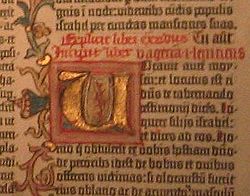Gutenberg Bible

The Gutenberg Bible (also known as the 42-line Bible or the Mazarin Bible) is a printed version of the Latin Vulgate translation of the Bible that was printed by Johannes Gutenberg, in Mainz, Germany in the 15th century. Although it is not the first book to be printed by Gutenberg's new movable type system,[1] it is his major work, and of central importance for the start of the "Gutenberg Revolution" and the "Age of the Printed Book". It is a very rare and expensive book. Fewer than 200 were made, and 49 complete or nearly complete ones are known. It has 1286 pages.

The earliest known book with movable type was published 78 years before in Korea and is known as the Jikji.[2]
The Gutenberg Bible had a profound effect on the history of the printed book. It also had an influence on future editions of the Bible, likethe 36 Line Bible, Mentelin's Latin Bible, and the first and third Eggestein Bibles. The third Eggestein Bible was set from the copy of the Gutenberg Bible now in Cambridge University Library. The Gutenberg Bible also had an influence on the Clementine edition of the Vulgate commissioned by the Papacy in the late sixteenth century.[3][4]
Gutenberg Bible Media
The copy of the Gutenberg Bible held at the Bibliothèque nationale de France
Gutenberg Bible in the Beinecke Rare Book & Manuscript Library at Yale University in New Haven, Connecticut
A vellum copy of the Gutenberg Bible owned by the U.S. Library of Congress, on display at the Thomas Jefferson Building in Washington, D.C.
First page of the first volume: the epistle of St Jerome to Paulinus from the University of Texas copy. The page has 40 lines.
Detail showing both rubrication (text in red) and illumination
Fragment of the Gutenberg Bible that was used as binding waste, now held by the Basel University Library.
Related pages
Notes
- ↑ Man, John (2002). "6". Gutenberg; How one man remade the world with words. New York: John Wiley and Sons, Inc. pp. 312. ISBN 0471218235. Retrieved 2008-05-18.
- ↑ Memory of the World, unesco.org, accessed November 2009
- ↑ Needham, Paul (1999). "The Changing Shape of the Vulgate Bible in Fifteenth-Century Printing Shops". In Saenger, Paul; Van Kampen, Kimberly (eds.). The Bible as Book:the First Printed Editions. British Library. pp. 53–70. ISBN 0-7123-4601-5.
- ↑ Needham, Paul (2010). "Copy Specifics in the Printing Shop". In Wagner, Bettina; Reed, Marcia (eds.). Early Printed Books as Material Objects: Proceedings of the Conference Organized by the Ifla Rare Books and Manuscripts Section Munich, 19–21 August 2009. De Gruyter Sur. pp. 9–20. ISBN 978-3-11-025324-5.
Other websites
- Treasures in Full: Gutenberg Bible Archived 2013-10-10 at the Wayback Machine Complete digitized texts of the two Gutenberg bibles in the British Library
- The University of Texas Ransom Center's Gutenberg Bible website including detailed images Archived 2002-10-16 at the Wayback Machine
- Online digital edition
- Gutenberg site made by the city of Mainz Archived 2006-09-23 at the Wayback Machine
- A complete list of digitized copies at German Wikipedia (in German)
| Wikimedia Commons has media related to Lua error in Module:Commons_link at line 62: attempt to index field 'wikibase' (a nil value).. |






